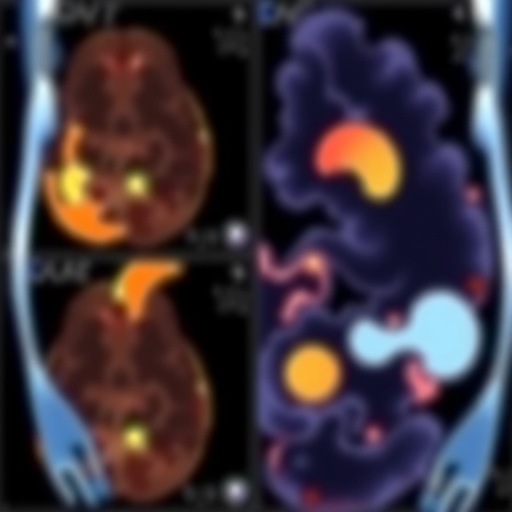In a groundbreaking advancement that promises to reshape the therapeutic landscape for glaucoma, researchers have unveiled a novel cell-based strategy to restore aqueous humor outflow, a critical factor in managing intraocular pressure and preventing vision loss. The study harnesses the remarkable potential of induced pluripotent stem cells (iPSCs) to produce ITGA6-positive cells, which demonstrate an unprecedented capacity to reinstate the natural fluid drainage pathway compromised in glaucoma-affected eyes. This discovery, detailed in a recent Nature Communications article, offers new hope for millions facing the relentless progression of this blinding disease.
Glaucoma, a group of eye conditions often linked to elevated intraocular pressure, leads to optic nerve damage and irreversible blindness. Central to the pathology is the impaired outflow of aqueous humor, the fluid responsible for maintaining eye shape and nutrient transport. The trabecular meshwork, a spongy tissue facilitating this drainage, frequently malfunctions during disease progression. Despite current pharmacological and surgical interventions, many patients experience insufficient pressure control, necessitating innovative approaches that target underlying cellular dysfunction.
The research team explored the therapeutic potential of patient-derived iPSCs differentiated into ITGA6-positive cells, a subpopulation believed to share critical properties with trabecular meshwork cells. ITGA6, an integrin implicated in cell adhesion and signaling, serves as a biomarker for selecting regenerative cells capable of integrating into the damaged tissue milieu. By transplanting these cells into glaucoma models, the investigators observed notable restoration of aqueous humor dynamics, suggesting functional incorporation and beneficial modification of the outflow pathways.
Methodologically, the study meticulously characterized the molecular and phenotypic identity of ITGA6-positive cells prior to transplantation. High-resolution imaging and gene expression profiling validated their resemblance to native trabecular meshwork cells, including the expression of extracellular matrix components and mechanotransduction elements crucial for pressure regulation. This rigorous characterization underpins the mechanistic understanding of how these cells interact with host tissues to promote physiological fluid drainage.
In vivo transplantation experiments, using sophisticated glaucoma animal models, provided compelling evidence of therapeutic efficacy. Subjects receiving iPSC-derived ITGA6-positive cells showed marked improvements in intraocular pressure metrics and maintenance of retinal ganglion cell integrity, key indicators of preserved visual function. Importantly, the intervention demonstrated a favorable safety profile, with no aberrant cell proliferation or immune rejection, highlighting its translational promise.
The implications of this study extend beyond cellular replacement therapy, offering insights into the microenvironmental cues and signaling pathways that govern trabecular meshwork homeostasis. The integrin-mediated interactions facilitated by ITGA6-positive cells may modulate extracellular matrix remodeling and endothelial function, processes that are crucial for sustaining unobstructed aqueous humor outflow. Understanding these mechanisms could catalyze the development of adjunctive treatments that enhance cell therapy outcomes.
Additionally, the use of iPSCs circumvents many ethical and immunological challenges associated with other stem cell sources. Patient-specific cells can be generated, reducing the risk of immune rejection and enabling personalized regenerative interventions. This approach aligns with the burgeoning paradigm of precision medicine, where therapeutic strategies are tailored to individual cellular and genetic profiles.
The study also addresses a significant barrier in glaucoma management: the lack of regenerative options targeted at the trabecular meshwork. While neuroprotective strategies and pressure-lowering drugs predominate current clinical practice, regenerating or replacing defective outflow tissue represents a paradigm shift. Such cellular therapies could complement existing treatments, offering durable solutions that mitigate disease progression at its source.
Challenges remain, particularly regarding the optimization of cell delivery methods and long-term integration within the complex ocular environment. Future research will need to refine transplantation protocols, ensure cell survival and functionality over extended periods, and evaluate efficacy across diverse patient populations and glaucoma subtypes. Nonetheless, this investigation lays vital groundwork for subsequent translational endeavors.
Moreover, the research emphasizes the utility of advanced stem cell technologies in ophthalmology, an emerging frontier that has seen successes in treating retinal degenerative diseases but has remained relatively underexplored for anterior segment disorders. By bridging this gap, the study opens new avenues for tackling other conditions characterized by aberrant tissue function or loss.
In the broader context of regenerative medicine, the demonstration that iPSC-derived ITGA6-positive cells can restore physiological function in a complex tissue system underscores the transformative potential of cell therapy. It exemplifies how combining stem cell biology with precise molecular targeting can yield restorative outcomes in tissues historically resistant to repair.
This research also invites considerations regarding regulatory pathways for approving cellular therapies, highlighting the importance of robust preclinical validation and the establishment of standardized manufacturing processes. Ensuring reproducibility and safety will be essential for transitioning from experimental models to widespread clinical use.
Overall, the discovery of ITGA6-positive cell transplantation as a means to restore aqueous humor outflow marks a milestone in glaucoma research. It invigorates hope for developing treatments that not only halt disease progression but actively reverse structural dysfunction within the eye, promising a future where vision preservation is substantially enhanced for at-risk populations.
Scientists and clinicians alike are eagerly anticipating developments stemming from these findings, which may soon translate into novel clinical protocols. As the field advances, interdisciplinary collaborations integrating stem cell biology, ophthalmology, and bioengineering will be pivotal in refining these therapies and ensuring their success.
The report, published in Nature Communications, has already garnered significant attention for its innovative approach and potential impact. Its detailed elucidation of cellular mechanisms, combined with practical demonstrations of therapeutic benefit, sets a new standard for research at the intersection of regenerative medicine and ophthalmic disease.
In conclusion, the utilization of iPSC-derived ITGA6-positive cells to restore aqueous humor outflow represents a beacon of innovation in glaucoma treatment. This research not only expands our understanding of disease pathophysiology but also exemplifies the promise of regenerative strategies in conquering complex, chronic conditions that have long challenged the medical community.
Article References:
Feng, P., Yu, C., Zhang, X. et al. iPSC-derived ITGA6-positive cells restore aqueous humor outflow in glaucoma eyes. Nat Commun 16, 9441 (2025). https://doi.org/10.1038/s41467-025-65475-8
Tags: aqueous humor outflow restorationcell-based glaucoma therapiesglaucoma treatment advancementsinduced pluripotent stem cells therapyinnovative glaucoma therapiesintraocular pressure managementiPSC-derived ITGA6-positive cellsNature Communications glaucoma studyoptic nerve damage solutionsregenerative medicine for eye diseasestrabecular meshwork dysfunctionvision loss prevention strategies




